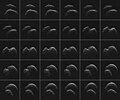
3122 Florence is a stony trinary asteroid of the Amor group. It is classified as a near-Earth object and potentially hazardous asteroid. It measures approximately 5 kilometers in diameter. It orbits the Sun at a distance of 1.0–2.5 AU once every 2 years and 4 months ; the orbit has an eccentricity of 0.42 and an inclination of 22° with respect to the ecliptic. Florence has two moons.

(7482) 1994 PC1 is a stony asteroid, classified as near-Earth object and potentially hazardous asteroid of the Apollo group, approximately 1.1 kilometers in diameter. It was discovered on 9 August 1994, by astronomer Robert McNaught at the Siding Spring Observatory in Coonabarabran, Australia. With an observation arc of 47 years it has a very well known orbit and was observed by Goldstone radar in January 1997. The 2022 approach has been observed every month since August 2021.
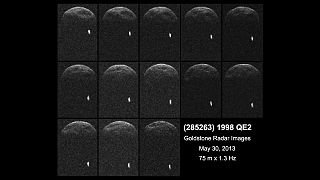
(285263) 1998 QE2, provisional designation 1998 QE2, is a dark asteroid and synchronous binary system, classified as near-Earth object and potentially hazardous asteroid of the Amor group, approximately 3 kilometers in diameter. It was discovered on 19 August 1998, by astronomers of the LINEAR program at Lincoln Laboratory's Experimental Test Site near Socorro, New Mexico, in the United States. Its sub-kilometer minor-planet moon was discovered by radar on 30 May 2013.
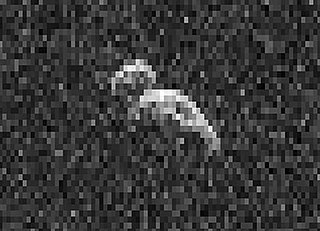
(388188) 2006 DP14, provisional designation 2006 DP14, is a sub-kilometer sized, peanut-shaped asteroid on a highly eccentric orbit, classified as near-Earth object and potentially hazardous asteroid of the Apollo group. This contact binary was discovered on 23 February 2006, by astronomers of the LINEAR program at the Lincoln Laboratory's Experimental Test Site near Socorro, New Mexico, in the United States. On 10 February 2014, it passed 6.25 lunar distances from Earth. The asteroid is approximately 400 meters in diameter and has a rotation period of 5.77 hours.

2014 HQ124 is a sub-kilometer asteroid, classified as near-Earth object and potentially hazardous asteroid of the Aten group, approximately 400 meters (1,300 feet) in diameter. It passed 3.25 lunar distances (LD) from Earth on 8 June 2014. It was discovered on 23 April 2014 by NEOWISE. It is estimated that an impact event would have had the energy equivalent of 2,000 megatons of TNT and would have created a 5 km (3 mi) impact crater. The news media misleadingly nicknamed it The Beast. 2014 HQ124 previously passed this close to Earth in 1952 and will not again until at least 2307. Radar imaging suggests it may be a contact binary.

2012 TC4 is a tumbling micro-asteroid classified as a bright near-Earth object of the Apollo group, approximately 10 meters (30 feet) in diameter. It was first observed by Pan-STARRS at Haleakala Observatory on the Hawaiian island of Maui, in the United States. As of 1 October 2017, it had a small Earth minimum orbital intersection distance of 0.000149 AU (22,300 km). On 12 October 2017, it passed Earth at 0.00033524 AU (50,151 km). The asteroid was removed from the Sentry Risk Table on 16 October 2017 and with a 5-year observation arc has a well-known orbit. For example, on the previously risk-listed date of 12 October 2022, it is now known that the asteroid will be more than 3 AU (450 million km) from Earth.
(456938) 2007 YV56, provisional designation 2007 YV56, is a sub-kilometer asteroid on an eccentric orbit, classified as a near-Earth object and potentially hazardous asteroid of the Apollo group, approximately 190–360 meters (620–1,200 ft) in diameter. It was discovered on 31 December 2007, by astronomers of the Catalina Sky Survey conducted at the Catalina Station in Arizona, United States.

2015 TB145 is a sub-kilometer asteroid, classified as near-Earth object and potentially hazardous asteroid of the Apollo group, approximately 650 meters (2,000 feet) in diameter. It safely passed 1.27 lunar distances from Earth on 31 October 2015 at 17:01 UTC, and passed by Earth again in November 2018.

2017 BQ6 is a sub-kilometer asteroid on an eccentric orbit, classified as a near-Earth object and potentially hazardous asteroid of the Apollo group, approximately 150 meters in diameter. It was discovered on 26 January 2017, by the Space Surveillance Telescope at Lincoln Laboratory's ETS (Atom Site) and passed within 6.6 lunar distances of Earth on 7 February 2017 at 6:36 UT.
2017 SX17 is a very small asteroid, classified as a near-Earth object of the Apollo group, approximately 6–12 meters (20–40 feet) in diameter. It was first observed by astronomers of the Mount Lemmon Survey at Mount Lemmon Observatory on 29 September 2017, three days prior to its sub-lunar close encounter with Earth at 0.23 lunar distances on 2 October 2017.
(162421) 2000 ET70 is a dark, elongated and oblate asteroid, classified as near-Earth object and potentially hazardous asteroid of the Aten group, approximately 2.2 kilometers in diameter. It was discovered on 8 March 2000, by astronomers of the Lincoln Near-Earth Asteroid Research at the Lincoln Laboratory's Experimental Test Site near Socorro, New Mexico. The body has a notably low albedo, and its shape resembles that of a "clenched fist".

(163899) 2003 SD220 is a sub-kilometer asteroid and tumbling slow rotator, classified as near-Earth object and potentially hazardous asteroid of the Aten group, which orbit the Sun between Venus and Earth. Its orbital period of 0.75 years means that it orbits the Sun about 4 times for every 3 of the Earth. It was discovered on 29 September 2003, by astronomers of the Lowell Observatory Near-Earth-Object Search at Anderson Mesa Station near Flagstaff, Arizona.

2017 OO1 is a small asteroid, classified as near-Earth object of the Aten group, approximately 35–76 meters (115–249 feet) in diameter. It was first observed on 23 July 2017, by the robotic ATLAS survey at Mauna Loa Observatory, Hawaii, two days after the object had approached Earth at 0.33 lunar distances on 21 July 2017.

(505657) 2014 SR339, provisional designation 2014 SR339, is a dark and elongated asteroid, classified as near-Earth object and potentially hazardous asteroid of the Apollo group, approximately 970 meters (3,200 feet) in diameter. It was discovered on 30 September 2014, by NASA's Wide-field Infrared Survey Explorer telescope (WISE) in Earth's orbit. Closely observed at Goldstone and Arecibo in February 2018, it has a rotation period of 8.7 hours.

2018 CF2 is a micro-asteroid and near-Earth object of the Apollo group on an eccentric orbit with has an estimated 4–15 meters (10–50 ft). It was first observed on 7 February 2018, by astronomers of the Mount Lemmon Survey at Mount Lemmon Observatory, Arizona, United States. The discovery occurred the day after its sub-lunar passage as it approached the Earth from a sunward direction, and this flyby altered the asteroid's orbit slightly.

2018 DV1 is a micro-asteroid, classified as a near-Earth object of the Aten group, approximately 6–12 meters (20–40 feet) in diameter. It was first observed on 26 February 2018, by astronomers of the Mount Lemmon Survey at Mount Lemmon Observatory, Arizona, five days prior to its sub-lunar close encounter with Earth at less than 0.3 lunar distance.
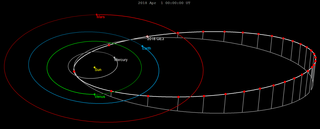
2018 GE3 is a sub-kilometer asteroid on a highly eccentric orbit, classified as a near-Earth object of the Apollo group, approximately 48–110 meters (160–360 feet) in diameter. It was first observed on 14 April 2018, by astronomers with the Catalina Sky Survey one day prior to its sub-lunar close encounter with Earth at 0.5 lunar distance. It is one of the largest known asteroids (possibly the largest) in observational history to ever pass that close to Earth (also see list).
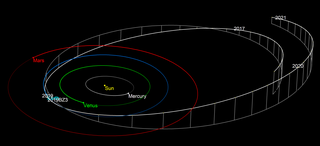
2019 BZ3 is a very small near-Earth asteroid of the Apollo group, approximately 6 meters (20 feet) in diameter. It was first observed by the Mount Lemmon Survey on 28 January 2019, just hours after the asteroid's sub-lunar flyby of Earth at less than 0.12 lunar distance.
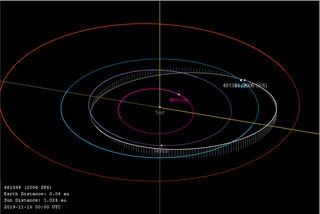
(481394) 2006 SF6 is a sub-kilometer near-Earth object and potentially hazardous asteroid of the Aten group, approximately 300 meters (1,000 feet) in diameter. It was discovered on 17 September 2006, by the Catalina Sky Survey at Catalina Station in Arizona. On 21 November 2019, it passed Earth at a distance of 11 lunar distances (0.0288 AU), which is the object's closest flyby for centuries. The stony A/S-type asteroid is highly elongated in shape and has a rotation period of 11.5 hours.

2016 DV1 is a near-Earth asteroid estimated to be roughly 29–65 meters (95–210 feet) in diameter. It is a fast rotating asteroid of the Apollo group which was first observed by the Mount Lemmon Survey on 28 February 2016, just days before it passed Earth at 1 lunar distance (LD) on 3 March 2016. The elongated fast rotator has a rotation period of 303 seconds. It was recovered in February 2021 as it was about to pass Earth on 3 March 2021 at a distance of 0.0053 AU (2.1 LD; 790,000 km; 490,000 mi).

